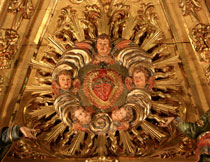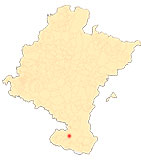The Church of the Company of Mary (Tudela)
By Ricardo Fernández Gracia
Among the earliest representations of a new devotion
subject These iconographies were undoubtedly due to the influence of the Jesuits who, in those years, spread devotion to the Sacred Hearts of Jesus and Mary through all kinds of means - missions, books, novenas, congregations and engravings - and particularly the apostle of devotion to the Sacred Heart, Father Juan de Loyola, who was at President at high school in Tudela between 1729 and 1732.
Navarra was the homeland of one of the main disseminators of the devotion to the Sacred Heart in his famous missions, following Father Hoyos. Thus, Father Calatayud, as well as the place of residency program of Father Loyola himself, another of the champions in the spread of the new cult, had a few sheets open in the middle decades of the 18th century for engravings, which were distributed in the kingdom and beyond by the missionaries who requested them from the Basilica of St. Ignatius in the capital of Navarre. The fact that numerous books on the Sacred Heart of Jesus came off the presses of Pamplona and that Father Sebastián de Mendiburu published his Jesusen Bihotza-ren Devocioa in Basque in 1751 can help us to better understand the diffusion and extension of the cult in Navarre. Between 1732 and 1746 more than 60 Congregations were founded in Navarre throughout the kingdom, counting among their congregants the bishop and such distinguished and influential nobles as the Duke of Granada de Ega, Don José Antonio de Guirior, Lord of Villanueva de Lónguida and translator of the Life of Saint Margaret of Alacoque and the Marquis of Góngora, among others.
-
PUIG Y ARBELOA, M. C., review histórica de la fundación del convento de religiosas de la Compañía de María y teaching de Tudela, Madrid, Imprenta a position de D. R. P. Infante, 1876.
-
FOZ Y FOZ, M. P., La revolución pedagógica en Nueva España 1754-1820 (María Ignacia de Azlor y Echeverz y los colegios de la teaching), Madrid, high school Gonzalo Fernández de Oviedo, 1981.
-
ECHEVERRÍA GOÑI, P., and FERNÁNDEZ GRACIA, R., "La arquitectura religiosa de los siglos XVI al XVIII en Navarra", Ibaiak eta Haranak. guide del Patrimonio artístico y paisajístico. Navarra, vol. VIII, San Sebastián, Etor, 1991.
-
AZANZA LÓPEZ, J. J., Arquitectura Religiosa Barroca en Navarra, Pamplona, Government of Navarre, 1996.
-
FERNÁNDEZ GRACIA, R., The Baroque altarpiece in Navarre. Pamplona, Government of Navarre, 2003.
-
CARRASCO NAVARRO, C., Los palacios barrocos de Tudela. Arquitectura y Nobleza, Tudela, Castel Ruiz- M. I. Ayuntamiento de Tudela, 2014.












